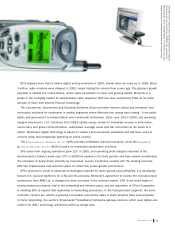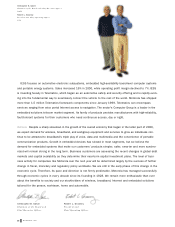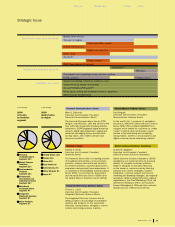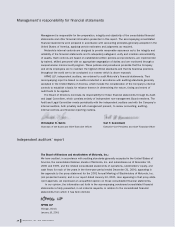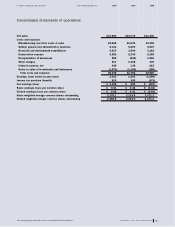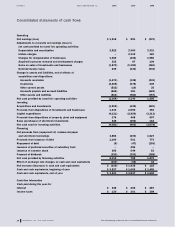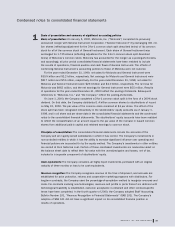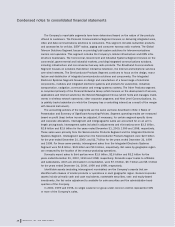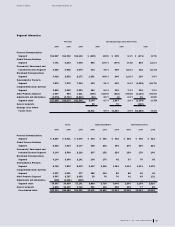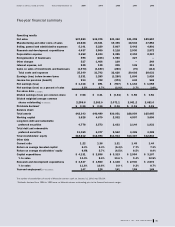Motorola 2000 Annual Report Download - page 27
Download and view the complete annual report
Please find page 27 of the 2000 Motorola annual report below. You can navigate through the pages in the report by either clicking on the pages listed below, or by using the keyword search tool below to find specific information within the annual report.
MOTOROLA, INC. AND SUBSIDIARIES 25
Condensed notes to consolidated financial statements
Basis of presentation and summary of significant accounting policies
Basis of presentation: On January 5, 2000, Motorola, Inc. (“Motorola”) completed its previously
announced merger with General Instrument Corporation (“General Instrument”) by exchanging 301 mil-
lion shares (reflecting adjustment for the 3-for-1 common stock split described below) of its common
stock for all of the common stock of General Instrument. Each share of General Instrument was
exchanged for 1.725 shares (reflecting adjustment for the 3-for-1 common stock split described
below) of Motorola’s common stock. Motorola has accounted for the merger as a pooling-of-interests,
and accordingly, all prior period consolidated financial statements have been restated to include
the results of operations, financial position and cash flows of General Instrument. The effects of
conforming General Instrument’s accounting policies to those of Motorola were not material.
For the year ended December 31, 1999, net sales for Motorola and General Instrument were
$30.9 billion and $2.2 billion, respectively. Net earnings for Motorola and General Instrument were
$817 million and $74 million, respectively. For the year ended December 31, 1998, net sales for
Motorola and General Instrument were $29.4 billion and $2.0 billion, respectively. The net loss for
Motorola was $962 million, and the net earnings for General Instrument were $55 million. Results
of operations for the year ended December 31, 2000 reflect the pooling-of-interests. Subsequent
references to “Motorola, Inc.” and “the Company” reflect the pooling-of-interests.
On June 1, 2000, the Company completed a 3-for-1 common stock split in the form of a 200% stock
dividend. On that date, the Company distributed 1.4 billion common shares to stockholders of record
on May 15, 2000. The par value of the common stock remained at $3 per share. The effect of the
stock split has been recognized retroactively in the stockholders’ equity accounts as of January 1,
1998, and in all share and per share data in the consolidated financial statements and the condensed
notes to the consolidated financial statements. The stockholders’ equity accounts have been restated
to reflect the reclassification of an amount equal to the par value of the increase in issued common
shares from additional paid-in capital and retained earnings to common stock.
Principles of consolidation: The consolidated financial statements include the accounts of the
Company and all majority-owned subsidiaries in which it has control. The Company’s investments in
non-controlled entities in which it has the ability to exercise significant influence over operating and
financial policies are accounted for by the equity method. The Company’s investments in other entities
are carried at their historical cost. Certain of these cost-based investments are marked-to-market at
the balance sheet date to reflect their fair value with the unrealized gains and losses, net of tax,
included in a separate component of stockholders’ equity.
Cash equivalents: The Company considers all highly liquid investments purchased with an original
maturity of three months or less to be cash equivalents.
Revenue recognition: The Company recognizes revenue at the time of shipment, and accruals are
established for price protection, returns and cooperative marketing programs with distributors. For
long-term contracts, the Company uses the percentage-of-completion method to recognize revenues and
costs. For contracts involving new technologies, revenues and profits or parts thereof are deferred until
technological feasibility is established, customer acceptance is obtained and other contract-specific
terms have been completed. In the fourth quarter of 2000, the Company adopted Staff Accounting
Bulletin Number 101, “Revenue Recognition in Financial Statements” (SAB 101). The Company’s
adoption of SAB 101 did not have a significant impact on its consolidated financial position or
results of operations.
1




